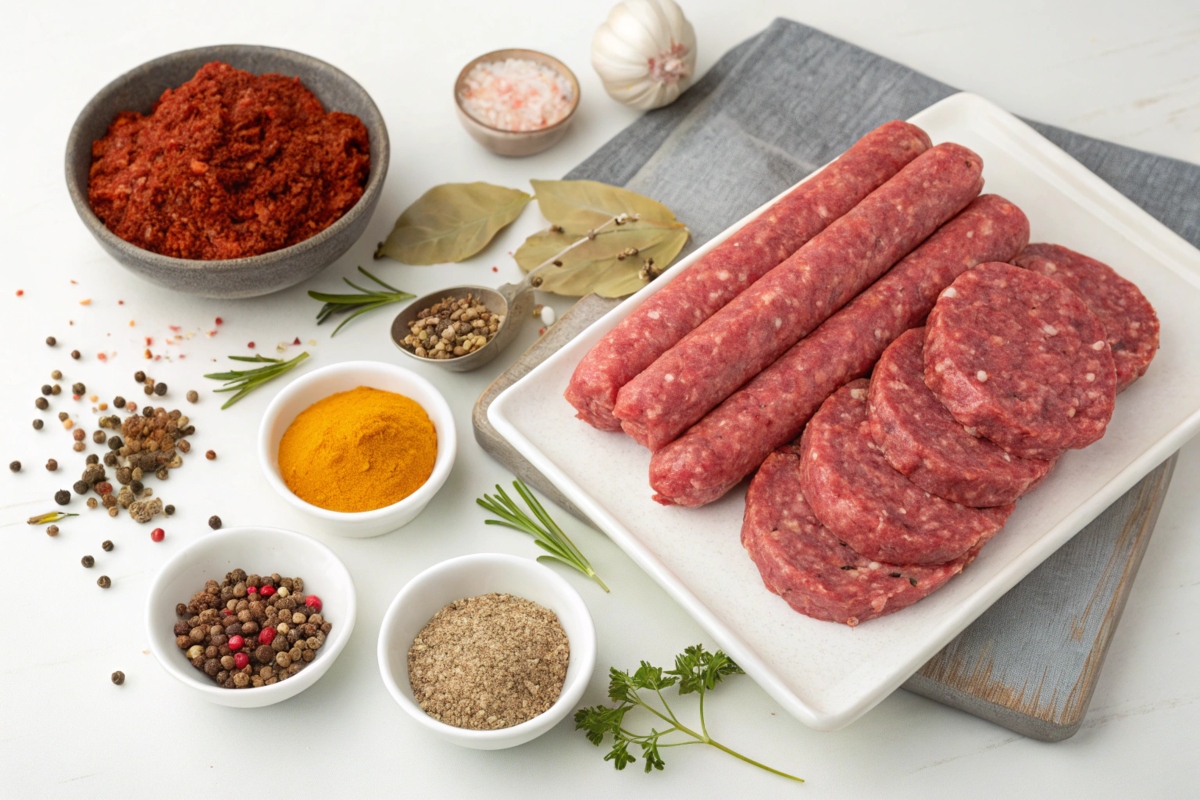Beef sausage health benefits is a popular food made from ground beef combined with a flavorful blend of seasonings. Moreover, these sausages can be prepared using fresh or smoked beef, offering different flavor profiles to suit various preferences. In addition, the texture is often enhanced with natural or artificial casings, which provide both structure and appeal. Furthermore, beef sausages are known for their versatility, as they can be grilled, fried, or baked, making them a staple in many cuisines worldwide. They also include spices like garlic, paprika, or black pepper, which add a unique taste to every bite.
One of the key factors contributing to their widespread appeal is their adaptability. For instance, you’ll find Beef sausage health benefits featured in breakfast dishes, hearty lunches, and even gourmet dinners. Additionally, the process of making these sausages has evolved over time; however, the focus on quality ingredients has always remained a priority. Therefore, when selecting Beef sausage health benefits, it’s important to consider the source and the preparation method to ensure optimal taste and nutrition.
Nutritional Value of Beef Sausage Recipes
Beef sausage health benefits provides many important nutrients, making it a good and flexible choice for different diets. For starters, it is rich in protein, which helps build and repair muscles. In addition, it contains vitamin B12, which keeps nerves healthy and supports the making of red blood cells. Also, it has iron, which helps move oxygen through the body.
The nutrients in Beef sausage health benefits can change depending on the ingredients. For example, sausages made from good-quality beef usually have more protein. Also, adding spices and herbs can provide antioxidants, which are good for your health. However, some sausages may include fillers, which lower their nutritional value.
To make healthier choices, choose beef sausages with fewer preservatives and natural casings. Also, check the sodium levels, as some types can have too much salt.
How Beef Sausages Are Made
Selecting the Beef
Start by picking high-quality beef cuts. The type of cut depends on the desired fat content. Common choices include chuck or brisket for a balance of meat and fat. Trim any excess sinew or gristle to avoid a chewy texture.
Grinding the Meat
Grind the beef to the desired consistency. A coarse grind creates a chunkier texture, while a fine grind gives a smoother bite. Use a clean and sharp grinder to maintain the meat’s freshness and texture.
Adding Seasonings
Mix the ground beef with a blend of seasonings. Popular choices include:
- Salt and black pepper for a basic flavor.
- Garlic powder, paprika, and fennel seeds for added depth.
- Herbs like thyme or parsley for a unique touch. Combine everything thoroughly to ensure even seasoning throughout the meat.
Stuffing the Sausage
Use a sausage stuffer to fill casings with the seasoned meat. Choose between:
- Natural casings (made from animal intestines): Provide a traditional texture and feel.
- Synthetic casings: Offer uniform size and appearance, ideal for commercial production.
Forming Links
Tie the stuffed sausages into even links. Twist each link tightly to prevent air pockets and maintain a consistent shape. Handle carefully to avoid breaking the casings.
Cooking or Preserving
Prepare the sausages based on the intended use:
- Smoking: Adds rich flavor and extends shelf life.
- Cooking: Fully cooks the sausage for immediate use.
- Fresh storage: Keeps raw sausages for grilling or frying later.
Key Factors for Quality
- Proper Grinding: Ensures a smooth or chunky texture, based on preference.
- Balanced Seasoning: Makes the sausage flavorful without overpowering the beef.
- Effective Smoking: Enhances taste while preserving the sausage.
Beef sausage health benefits Recipes
Eating beef sausage in moderation can offer many health benefits, thanks to its rich nutrients. To begin with, it is packed with protein, which helps maintain energy levels and supports muscle growth. Additionally, beef sausage contains essential amino acids, which the body needs but cannot make on its own. This makes it a great addition to a balanced diet.
Moreover, Beef sausage health benefits provides iron, which is important for preventing anemia. Iron helps the body transport oxygen more effectively, keeping you energized and healthy. On top of that, it also contains zinc, which strengthens the immune system and helps wounds heal faster. Furthermore, some types of beef sausage include healthy fats. These fats provide lasting energy and help you feel full, reducing the urge to snack on less nutritious foods.
By making these thoughtful choices, you can enjoy beef sausage while supporting your overall health. Check out our Quick Spinach Tomato Pasta Recipe: Easy, Healthy, and Delicious
Choosing Quality Beef Sausages
When choosing beef sausage, focusing on quality is very important to get great taste and health benefits. First, pick sausages made with 100% beef and few additives to ensure they are pure and natural. Also, read the labels carefully to find options with fewer preservatives and less salt, which are better for a balanced diet. In addition, sausages made from grass-fed beef often taste better and have more nutrients, making them a smart choice for healthy eating.
- Clear ingredient lists: Choose products with simple labels and no hidden fillers or unnecessary additives.
- Natural casings: Look for sausages with natural casings for a better texture and flavor.
- Reputable sources: Buy from trusted butchers or well-known brands to ensure good quality and safety.
By selecting high-quality beef sausage, you can enjoy tasty meals that fit your dietary needs and support a healthier lifestyle. check out this Beef Heart Recipe for inspiration.
Cooking Methods for Beef sausage health benefits Recipes
Cooking beef sausage properly is crucial to achieving the best flavor and texture. To start with, pan-frying is one of the most popular methods, as it creates a crispy outer layer while ensuring the inside remains juicy and tender. Additionally, grilling is an excellent choice for outdoor gatherings, as it imparts a smoky flavor that enhances the Beef sausage health benefits natural taste. Alternatively, baking offers a convenient, hands-off approach, making it ideal for busy cooks or large batches.
- Cook sausages on medium heat: This prevents the meat from drying out while allowing it to cook evenly.
- Use a meat thermometer: Ensure the internal temperature reaches 160\u00b0F to confirm the sausage is fully cooked.
- Avoid piercing the casing: This helps retain the juices, preserving flavor and texture.
Beef sausage health benefits Recipes
Adding beef sausage to recipes can make dishes richer and more flavorful. For example, a simple sausage and vegetable stir-fry pairs sliced beef sausage with colorful peppers and onions, creating a tasty and eye-catching meal. Also, a hearty beef sausage casserole with potatoes, tomatoes, and fresh herbs baked to perfection is always a favorite for family dinners or gatherings.
Here are some easy recipe ideas to try Beef sausage health benefits:
- Breakfast Hash: Mix diced beef sausage with eggs, potatoes, and spinach for a filling and protein-rich breakfast.
- Pasta Dishes: Add sliced beef sausage to creamy Alfredo or tangy marinara sauces to make your pasta dishes more flavorful.
- Soups: Use beef sausage in lentil or vegetable soups to enhance both the flavor and texture, giving the dish a rich, meaty taste.
For a Mexican twist, try this delicious Beef Quesadilla Recipe, which can be easily modified by adding beef sausage for an extra kick.
Pairing Beef Sausage with Other Foods
For example, serve sausages with scrambled eggs and toast for a hearty and protein-packed breakfast. For lunch, pair beef sausage with fresh salads or whole-grain sandwiches for a lighter but still tasty option.
Here are some simple pairing ideas Beef sausage health benefits:
- Grilled Vegetables: Serve beef sausage with zucchini, bell peppers, or asparagus for a smoky and healthy side dish.
- Cheese Platters: Pair beef sausage with sharp cheddar, creamy brie, or other cheeses for a fun and tasty snack or appetizer.
- Sauces and Dips: Add extra flavor to beef sausage with mustard, barbecue sauce, or aioli.
For those seeking more hearty beef dishes, consider this Beef Back Ribs Recipe as another exciting option to complement your beef sausage creations.
Conclusion
Beef sausage brings rich flavor to many meals and fits well with a variety of diets. It is packed with nutrients that support overall health. For instance, you can pair it with fresh vegetables for a balanced dish or mix it into casseroles and pasta for a hearty, satisfying meal. Whether grilled, fried, or baked, beef sausage is versatile and available in both smoked and fresh forms to suit your taste.
No matter how you prepare it, beef sausage is a flavorful and healthy option that works well in meals throughout the day.Check Homemade Beef
FAQs
What sausage is made from beef?
Cooks make beef sausages using ground beef as the main ingredient. They add seasonings, herbs, and spices to give the sausages unique flavors. Fresh, smoked, and cured types of beef sausages give you different options for cooking and recipes.
How you cook them affects their texture and taste.
Their variety of flavors and forms makes beef sausages a great addition to many meals.
Are beef sausages better than pork?
The choice between beef sausages and pork sausages depends on personal taste, dietary needs, and flavor preferences. Beef sausage health benefits usually have a richer and stronger flavor, making them a good option for hearty meals. They are also a popular choice for people who avoid pork for personal or religious reasons. In contrast, pork sausages are often milder and juicier because of their higher fat content.
Is ground beef and beef sausage are the same thing?
No, ground beef and beef sausage are not the same. Ground beef contains only minced or finely chopped beef, with no added ingredients. Cooks use ground beef in recipes like burgers and meatballs because it works well in many dishes.
What meat is best for beef sausage?
Common cuts for beef sausage include chuck, brisket, or a mix of lean and fatty pieces. The fat is important because it makes the sausage taste better and improves the texture. Many people choose grass-fed beef because it has a richer flavor and more nutrients.



